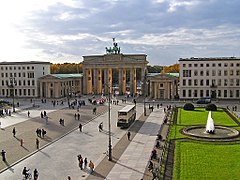Brandenburg Gate
| Brandenburg Gate | |
|---|---|
Brandenburger Tor | |
 The Brandenburg Gate | |
| General information | |
| Type | City gate |
| Architectural style | Neoclassical |
| Location | Berlin, Germany |
| Coordinates | 52°30′58.58″N 13°22′39.80″E / 52.5162722°N 13.3777222°E |
| Construction started | 1788 |
| Completed | 1791 |
| Design and construction | |
| Architect(s) | Carl Gotthard Langhans |
The Brandenburg Gate (Template:Lang-de) is an 18th-century neoclassical monument in Berlin, and one of the best-known landmarks of Germany. It is built on the site of a former city gate that marked the start of the road from Berlin to the town of Brandenburg an der Havel.
It is located in the western part of the city centre of Berlin within Mitte, at the junction of Unter den Linden and Ebertstraße, immediately west of the Pariser Platz. One block to the north stands the Reichstag building, which houses the German parliament (Bundestag). The gate is the monumental entry to Unter den Linden, the renowned boulevard of linden trees, which led directly to the royal City Palace of the Prussian monarchs.
It was commissioned by King Frederick William II of Prussia as a sign of peace and built by architect Carl Gotthard Langhans from 1788 to 1791. Having suffered considerable damage in World War II, the Brandenburg Gate was restored from 2000 to 2002 by the Stiftung Denkmalschutz Berlin (Berlin Monument Conservation Foundation).[1]
During the post-war Partition of Germany, the gate was isolated and inaccessible immediately next to the Berlin Wall. The area around the gate was featured most prominently in the media coverage of the tearing down of the wall in 1989, and the subsequent German reunification in 1990.
Throughout its existence, the Brandenburg Gate was often a site for major historical events and is today considered not only as a symbol of the tumultuous history of Europe and Germany, but also of European unity and peace.
History
This section needs additional citations for verification. (December 2014) |
Design and construction
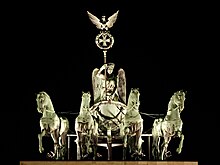

In the time of Frederick William (1688), shortly after the Thirty Years' War and a century before the gate was constructed, Berlin was a small walled city within a star fort with several named gates: Spandauer Tor, St. Georgen Tor, Stralower Tor, Cöpenicker Tor, Neues Tor, and Leipziger Tor (see map). Relative peace, a policy of religious tolerance, and status as capital of the Kingdom of Prussia facilitated the growth of the city.

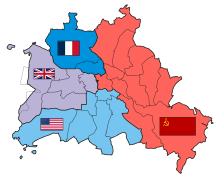
The Brandenburg Gate was not part of the old fortifications, but one of 18 gates within the Berlin Customs Wall (Template:Lang-de), erected in the 1730s, including the old fortified city and many of its then suburbs.
The new gate was commissioned by Friedrich Wilhelm II to represent peace. The Gate was designed by Carl Gotthard Langhans, the Court Superintendent of Buildings, and built between 1788 and 1791, replacing the earlier simple guard houses siding the original gate in the Customs Wall. The gate consists of 12 Doric columns, six to each side, forming five passageways. Citizens originally were allowed to use only the outermost two on each side. Atop the gate is a Quadriga, a chariot drawn by four horses. The new gate was originally named the Peace Gate (German: Friedenstor)[2] and the goddess is Eirene, the goddess of peace.
The gate's design is based upon the Propylaea, the gateway to the Acropolis in Athens, Greece, and is consistent with Berlin's history of architectural classicism (first, Baroque, and then neo-Palladian). The gate was the first "Athens on the River Spree" by architect Carl Gotthard von Langhans. The capital Quadriga was sculpted by Johann Gottfried Schadow.
19th and early 20th centuries
The Brandenburg Gate has played different political roles in German history. After the 1806 Prussian defeat at the Battle of Jena-Auerstedt, Napoleon was the first to use the Brandenburg Gate for a triumphal procession,[3] and took its Quadriga to Paris.[4]
After Napoleon's defeat in 1814 and the Prussian occupation of Paris by General Ernst von Pfuel, the Quadriga was restored to Berlin.[5] It was now redesigned by Karl Friedrich Schinkel for the new role of the Brandenburg Gate as a Prussian triumphal arch; the goddess, now definitely Victoria, was equipped with the Prussian eagle and Iron Cross on her lance with a wreath of oak leaves.[2]
The Quadriga faces east, as it did when it was originally installed in 1793. Only the royal family was allowed to pass through the central archway,[4] as well as members of the Pfuel family, from 1814 to 1919. The Kaiser granted this honour to the family in gratitude to Ernst von Pfuel, who had overseen the return of the Quadriga to the top of the gate.[6] In addition, the central archway was also used by the coaches of ambassadors on the single occasion of their presenting their letters of credence to council.
When the Nazis ascended to power, they used the gate as a party symbol. The gate survived World War II and was one of the damaged structures still standing in the Pariser Platz ruins in 1945 (another being the Academy of Fine Arts). The gate was badly damaged with holes in the columns from bullets and nearby explosions. One horse’s head from the original quadriga survived, today kept in the collection of the Märkisches Museum.
Cold War
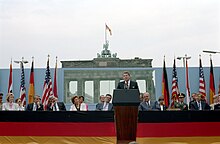
Following Germany's surrender and the end of the war, the governments of East Berlin and West Berlin restored it in a joint effort. The holes were patched, but were visible for many years following the war.
Vehicles and pedestrians could travel freely through the gate, located in East Berlin, until the Berlin Wall was built, 13 August 1961. Then one of the eight Berlin Wall crossings was opened on the eastern side of the gate, usually not open for East Berliners and East Germans, who from then on needed a hard-to-obtain exit visa. On 14 August, West Berliners gathered on the western side of the gate to demonstrate against the Berlin Wall, among them West Berlin's governing Mayor Willy Brandt, who had spontaneously returned from a federal election campaigning tour in West Germany earlier on the same day.
Under the pretext that Western demonstrations required it, the East closed the checkpoint at the Brandenburg Gate the same day, 'until further notice', a situation that was to last until 22 December 1989. The wall was erected as an arc just west of the gate, cutting off access from West Berlin. On the eastern side, the "baby Wall", drawn across the eastern end of Pariser Platz rendered it off limits to East Berliners, as well. The section of wall in front of the gate was built shorter and wider to protect it from a potential Western invasion in the event of a war breaking out between the two superpowers.
Post-1989
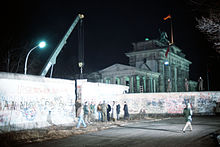
When the Revolutions of 1989 occurred and the wall was demolished, the gate symbolized freedom and the desire to unify the city of Berlin. Thousands of people gathered at the wall to celebrate its fall on 9 November 1989. On 22 December 1989, the Brandenburg Gate border crossing was reopened when Helmut Kohl, the West German chancellor, walked through to be greeted by Hans Modrow, the East German prime minister. Demolition of the rest of the wall around the area took place the following year.
During 1990, the quadriga was removed from the gate as part of renovation work carried out by the East German authorities following the fall of the wall in November 1989. Germany was officially reunified in October 1990.
On 21 December 2000, the Brandenburg Gate was privately refurbished at a cost of six million euros.
On 3 October 2002, the 12th anniversary of German reunification, the Brandenburg Gate was once again opened following extensive refurbishment.
Brandenburg Gate became the main venue for the 20th-anniversary celebrations of the fall of the Berlin Wall or "Festival of Freedom" on the evening of 9 November 2009. The high point of the celebrations was when over 1000 colorfully designed foam domino tiles, each over 2.5 m tall, were lined up along the route of the former wall through the city centre. The domino "wall" was then toppled in stages converging here.[7]
The Brandenburg Gate is now again closed to vehicle traffic, and much of Pariser Platz has been turned into a cobblestone pedestrian zone. The gate, along with the broad Straße des 17. Juni avenue to the west, is also one of the large public areas in Berlin where over a million people can gather to watch stage shows or party together, watch major sport events shown on huge screens, or see fireworks at midnight on New Year's Eve.[8] After winning the 2014 FIFA World Cup, the Germany national football team held their victory rally in front of the gate.
It has also hosted street events at 2009 IAAF World Championships in Athletics and will repeat its role in 2018 European Athletics Championships. It is also the usual finish line of Berlin Marathon.



Photo gallery
-
Napoleon passing through the Brandenburg Gate after the Battle of Jena-Auerstedt (1806). Painted by Charles Meynier in 1810.
-
The Gate in 1928
-
The Gate in 1930's
-
Brandenburg Gate in 1945 badly damaged just after the end of World War II
-
In 1984, East Berliners and others were kept away from the Gate, which they could view only from this distance.
-
The Berlin Wall in front of the Brandenburg Gate, shortly before its fall in 1989
-
Gate with Pariser Platz
-
The Brandenburg Gate as seen from the rooftop terrace of the Reichstag building, with the United States Embassy in the background
-
Brandenburg Gate in 2003
-
At night
-
In 2012
-
The Quadriga with skyscrapers of Potsdamer Platz
-
Brandenburg gate lit up to look like the French Flag after the November 2015 Paris attacks
-
Dark silhouette impression at sunset, 21 August 2010
Political history at the gate

A Soviet flag flew from a flagpole atop the gate from 1945 until 1957, when it was replaced by an East German flag. Since the reunification of Germany, the flag and the pole have been removed.
In 1963, U.S. President John F. Kennedy visited the Brandenburg Gate. The Soviets hung large red banners across it to prevent him looking into East Berlin.
In the 1980s, decrying the existence of two German states and two Berlins, West Berlin mayor Richard von Weizsäcker said: "The German question is open as long as the Brandenburg Gate is closed."[9]
On 12 June 1987, U.S. President Ronald Reagan spoke to the West Berlin populace at the Brandenburg Gate, demanding the razing of the Berlin Wall.[10][11] Addressing the General Secretary of the Communist Party of the Soviet Union, Mikhail Gorbachev, Reagan said,
General Secretary Gorbachev, if you seek peace, if you seek prosperity for the Soviet Union and Eastern Europe, if you seek liberalization: Come here to this gate! Mr. Gorbachev, open this gate! Mr. Gorbachev, tear down this wall!
On 25 December 1989, less than two months after the Berlin Wall began to come down, the conductor Leonard Bernstein conducted the Berlin Philharmonic in a version of the Ninth Symphony of Beethoven at the then newly opened Brandenburg Gate. In the concluding choral movement of the symphony, the famous "Ode to Joy", the word Freude ("Joy") was replaced with Freiheit ("Freedom") to celebrate the fall of the Wall and the imminent reunification of Germany.
On 2–3 October 1990, the Gate was the scene of the official ceremony to mark the reunification of Germany. At the stroke of midnight on 3 October, the black-red-gold flag of West Germany—now the flag of a reunified Germany—was raised over the Gate.
On 12 July 1994, U.S. President Bill Clinton spoke at the Gate about peace in post–Cold War Europe.
On 9 November 2009, Chancellor Angela Merkel, walked through Brandenburg Gate with Russia’s Mikhail Gorbachev and Poland's Lech Wałęsa as part of the 20-year celebration of tearing down the Berlin Wall.[13][14]
On 13 August 2011, Germany marked the 50th anniversary of the day the Berlin Wall started to go up with a memorial service and a minute of silence in memory of those who died trying to flee to the West. "It is our shared responsibility to keep the memory alive and to pass it on to the coming generations as a reminder to stand up for freedom and democracy to ensure that such injustice may never happen again," Berlin Mayor Klaus Wowereit said. German Chancellor Angela Merkel—who grew up behind the wall in Germany's communist eastern part—also attended the commemoration. German President Christian Wulff added, "It has been shown once again: Freedom is invincible at the end. No wall can permanently withstand the desire for freedom."[15][16][17]
On 19 June 2013, U.S. President Barack Obama spoke at the Gate about nuclear arms reduction and the recently revealed U.S. internet surveillance activities.[18]
On the night of 5 January 2015, the lights illuminating the gate were completely shut off in protest against the far-right anti-Islamic Pegida demonstration.[19][20][21]
See also
- Mitte (locality)
- Puerta de Alcalá – a similar structure in Madrid
- Siegestor – a similar structure in Bavaria
References
- ^ "Das Brandenburger Tor" (in German). Die Stiftung Denkmalschutz Berlin. Retrieved 14 May 2011.
{{cite web}}: Unknown parameter|trans_title=ignored (|trans-title=suggested) (help) - ^ a b "Denkmale in Berlin. Brandenburger Tor". Senatsverwaltung für Stadtentwicklung und Umwelt, Berlin. Retrieved 5 August 2013.
- ^ "Deutsches Historisches Museum". Dhm.de. Retrieved 25 April 2014.
- ^ a b Dunton, Larkin (1742). The World and Its People. Silver, Burdett. p. 188.
- ^ Sullivan, Paul (2016). "Brandenburg Gate". Pocket Rough Guide Berlin. London: Penguin Random House. p. 72. Retrieved 9 May 2016.
{{cite book}}:|work=ignored (help) - ^ Dedio, Florian; Dedio, Gunnar (2013). "Berlin, Germany, before the war". The Great War Diaries: Breathtaking Colour Photographs from a World Torn Apart. London: BBC Books, Penguin Random House. p. 50. Retrieved 6 May 2016.
- ^ "20 Jahre Mauerfall" (in German). Kulturprojekte Berlin GmbH. 2009. Retrieved 9 April 2009.
- ^ "Berlin feiert am Brandenburger Tor ins neue Jahr 2013 (in German)". Berliner Morgenpost. 4 March 2007.
- ^ "Remarks on East-West Relations at the Brandenburg Gate in West Berlin". Retrieved 9 January 2015.
- ^ "Remembering Reagan's "Tear Down This Wall" speech 25 years later". CBS News. 12 June 2012.
- ^ "Lessons from Reagan after "Tear down this wall" speech". CBS News. 12 June 2012.
- ^ "20 Jahre Mauerfall :: "Fest der Freiheit" zum 20. Jahrestag des Mauerfalls". Mauer.host8.3-point.de. Retrieved 25 April 2014.
- ^ "Germany Celebrates Fall of the Berlin Wall". FoxNews. 9 November 2009. Retrieved 31 August 2010.
- ^ "Fall of the Berlin Wall [slides/captions]". FoxNews. 9 November 2009. Retrieved 31 August 2010.
- ^ "Germany marks 50th anniversary of Berlin Wall". London: UK Telegraph. 13 August 2011. Retrieved 13 August 2011.
- ^ "Germany Marks Construction of the Berlin Wall". Fox News. Associated Press. 13 August 2011. Retrieved 13 August 2011.
- ^ "Reflecting on the Berlin Wall, 50 Years After Its Construction". History.com. 11 August 2011. Retrieved 13 August 2011.[permanent dead link]
- ^ Roberts, Dan; Connolly, Kate (19 June 2013). "Obama calls for reduction in nuclear arms in broad-brush Berlin speech". The Guardian. London.
- ^ Tagesspiegel: Bärgida und Gegendemonstration beendet (in German), 5 January 2015, retrieved 20 November 2015
- ^ RBB: Licht aus am Brandenburger Tor (in German) "Lights off at Brandenburg Gate", 5 January 2015, retrieved 20 November 2015
- ^ Storify: Anti-islamization rally in Germany met with countrywide protests, 5 January 2015, retrieved 20 November 2015
External links
This article's use of external links may not follow Wikipedia's policies or guidelines. (March 2013) |
- Brandenburg-gate.de: official Brandenburg Gate website
- Stiftung Denkmalschutz Berlin (Berlin Monument Conservation Foundation)
- Brandenburg Gate described in its historic context.
- Panorama Brandenburg Gate - Panoramic view from the Pariser Platz
- Webcam: Live-View of the Street "Unter den Linden" with Brandenburg Gate in Berlin, Germany
- Ronald Reagan's Tear this Wall speech
- Complete text, audio and video of Ronald Reagan's Brandenburg Gate Address from AmericanRhetoric.com
- Bill Clinton's Berlin is free speech
- Video News report of the Brandenburg Gate re-opening - RealPlayer needed
- Germany, Berlin, Brandenburger Tor Virtual tour with map and compass effect by Tolomeus
- Panorama Brandenburg Gate 1945 - Panoramic view into the past, 60 years after World War II
- Celebrating 20 years after tearing down the Berlin wall, 1989 - Pictures at Brandenburg Gate on 9 November 2009
- Panoramen und weitere Bilder vom Brandenburger Tor
- Three-dimensional view of Brandenburger Gate (without plugin English, German, Spanish)
- German version of this article.
- Works about Brandenburg Gate in libraries (WorldCat catalog)
- Wikipedia external links cleanup from March 2013
- Gates in Germany
- Buildings and structures in Mitte
- Monuments and memorials in Berlin
- Triumphal arches in Germany
- Berlin border crossings
- Terminating vistas
- Heritage sites in Berlin
- Visitor attractions in Berlin
- National symbols of Germany
- Prussian cultural sites
- Buildings and structures completed in 1791
- 1791 establishments in Germany
- Classicist architecture in Germany
- Greek Revival architecture in Germany
- Neoclassical architecture in Berlin
- Subjects of iconic photographs







